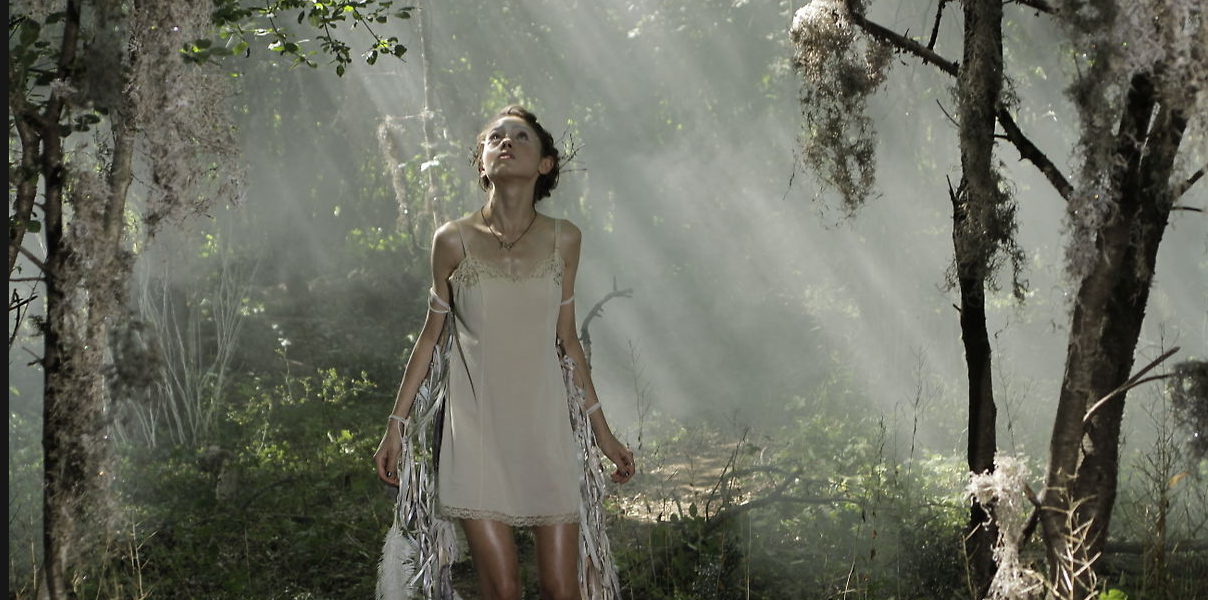Leah Meyerhoff’s film I Believe in Unicorns tells the story of Divina (Natalia Dyer), a sixteen-year-old girl who believes in unicorns. She is also the full time carer of her quadriplegic mother. In one of the opening scenes, Divina comes into the kitchen and puts on her mother’s stockings. They don’t speak to each other. It is Divina’s birthday and when she comes home from school she has a cake with her mother while wearing a tiara. After this, her mother presents her with her gift – a flashing glitter ball. It is a gift you would buy for your cat and not for your sixteen year old daughter, so understandably Divinia is disappointed. She retires to her room which is plastered in pictures of unicorns and dolls and other girly things more fitting for a five year old than for a sixteen year old, and her doe eyes fill with tears.
Divina’s life changes when she meets Stirling (Peter Vack) – the skateboarding rockstar with the aggressively masculine name. Stirling is older and more experienced than Divina. He likes to speak with an unlit cigarette dangling from his terse pout. She sees him skateboarding in the park and thinks he’s cute, so she takes photos of him with her Polaroid camera. This is a creepy thing to do, but Divina pulls it off because she’s very pretty. Perhaps Stirling is flattered by her fandom, perhaps he’s just horny. He tells her to meet him on the corner and writes the instructions all over her arm in a marker pen then commando rolls back to his skateboard. This is pretty weird. I also felt that it romanticised what seemed to me a gross violation of Divina’s bodily autonomy. Personally, if some guy came up to me and wrote instructions all over my body on how to meet up with him I would respond differently. But maybe I’m overreacting. Maybe it’s cute.
Luckily for Stirling, Divina responds by swooning. She meets up with him and he wows her with his skills at purchasing food from a vending machine. Then there is an upside-down shot of Divina’s head bobbing in and out of the frame because she is jumping on a trampoline. Her conversation with Stirling is heard in voiceover (and later his bobbing head enters the frame also, with its ever-resplendent appendage of the unlit cigarette). Their conversation is quite obtuse:
She says, “I could tame you, break you.”
“Not a chance.”
“I will spread my wings and smother you with a million tiny feathers.”
“I’ll light your feathers on fire and watch them turn to ash.”
“I will sweep the ashes into my hands and sprinkle them into the ocean.”
I’m unsure what is meant by these threats of violence, thinly veiled by cliché. Perhaps Meyerhoff is suggesting that first love and infatuation is about wanting to totally possess the other person. (Think Twilight.) Perhaps she is foreshadowing the violence that is to come later in the film. Either way, the execution falls flat. I found the first half of the film annoying and the characters underdeveloped. I hoped that the Meyerhoff would explore the dynamics of Divina’s relationship with her disabled mother, but they do not exchange a word throughout the entire film. The disabled mother remains nothing more than a plot device – she represents the underwhelming reality that Divina seeks to escape, first by daydreaming about unicorns, and later by running away with Stirling.
The unicorn motif is also unsuccessful. There are recurrent scenes of unicorns in meadows and Divina running around with grass woven into her hair. These scenes are filmed with clay in stop-start animation, reminiscent of a Michel Gondry film. At first, Divina sees Stirling as representing a unicorn and she as the virgin who needs to tame him. But later she realizes that he is actually a giant dragon that slays the unicorn. It is frustrating that the female protagonist could only make sense of her relationship in terms of simplistic unicorn metaphors. Gondry’s films are beautiful because their animation sequences are so whimsical and surreal. The animation sequences in I Believe in Unicorns, particularly in the context of the film’s lo-fi aesthetic, were nothing more than imitation fashion spreads from Yen magazine. Consider Gondry’s film, The Science of Sleep (2006). Like Divina, the protagonist, Stefan, is stuck in his own dream world. Unlike Divina, his dream world is an entire universe – an original and witty representation of his own neuroses. All Divina has is the recurring image of a unicorn in a forest. Gondry drives the plot by forcing Stefan’s dream world to collide with reality. Meyerhoff never does this. Divina’s fantasy world continues in parallel, tangential fashion, and Divina herself remains an inchoate, fragile creature. She refuses to engage in reality, and while her alternate fantasies may be safer for her, they are, for the audience, somewhat infantile and boring.
The film’s ending is much better than its beginning, mostly because there are some allusions to a grittier reality. The relationship between Divina and Stirling becomes slightly more complex and real. Still, this did not salvage the film. The references to the complexities of adolescent desire, domestic violence and rape seemed somewhat token and incompletely explored. For me, the biggest problem was not only the superficial characterisation of Stirling, but more so of Divina. She was impossible to empathise with, mainly because she was so tied up in her strange two-dimensional fantasy world that she evoked at best a five year old child, and at worst, an inchoate personification of stereotyped femininity.
Around the Staff
| Dominic Barlow |

